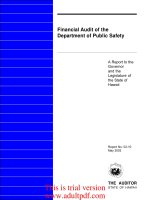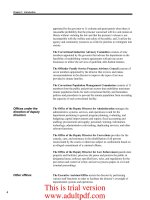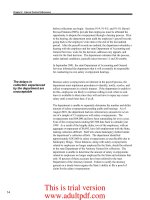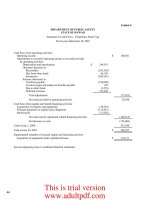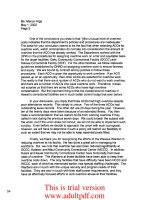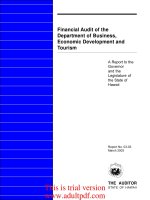Financial Audit of the Department of Public Safety A Report to the Governor and the Legislature _part5 pptx
Bạn đang xem bản rút gọn của tài liệu. Xem và tải ngay bản đầy đủ của tài liệu tại đây (252.98 KB, 10 trang )
34
Chapter 3: Financial Audit
Net property, plant, and equipment in the internal service fund at
June 30, 2001, consisted of the following:
The general long-term debt account group is used to account for the
long-term portion of the obligation for accrued vested vacation and
compensatory time. The obligation changed during the fiscal year ended
June 30, 2001, as follows:
Payroll fringe benefit costs of the department’s employees funded by
state appropriations (general fund) are assumed by the State and are not
charged to the department’s operating funds. These costs, totaling
$18,939,403, for the fiscal year ended June 30, 2001, have been reported
as revenues and expenditures of the department’s general fund.
Payroll fringe benefit costs related to federally-funded salaries are not
assumed by the State and are recorded as expenditures in the
department’s special revenue fund.
The general fund had a deficit in the unreserved fund balance at June 30,
2001, of $3,179,907. The deficit resulted primarily from reservations of
the fund balance for encumbrances and receivables.
The agency fund is purely custodial in nature (assets equal liabilities)
and thus does not involve the measurement of results of operations. The
changes in assets and liabilities of the agency fund for the fiscal year
ended June 30, 2001, were as follows:
Buildings, improvements, equipment,
furniture, and fixtures
$
2,093,814
Less accumulated depreciation (1,848,750)
245,064
Leased equipment under capital leases,
less accumulated amortization of
$228,563
377,441
$ 622,505
Note 7 – General Long-
Term Debt
Balance at July 1, 2000 $ 13,756,819
Net decrease (620,545)
Balance at June 30, 2001 $ 13,136,274
Note 8 – Non-Imposed
Employee Fringe
Benefits
Note 9 – Fund Balance
Deficits
Note 10 – Changes in
Assets and Liabilities
of the Agency Fund
This is trial version
www.adultpdf.com
35
Chapter 3: Financial Audit
Capital Leases
The department’s Correctional Industries Division has long-term
equipment leases expiring through August 2004 that are accounted for as
capital leases in the internal service fund. These leased equipment are
amortized using the straight-line method over the estimated useful life of
the equipment. The amortization is included in depreciation and
amortization expense of the internal service fund and amounted to
approximately $102,700 for the fiscal year ended June 30, 2001.
At June 30, 2001, the future minimum lease payments and the present
value of net minimum lease payments (obligations under capital leases)
were as follows:
Operating Leases
The department leases equipment on a long-term basis that are reported
in the general and internal service funds. As of June 30, 2001, future
minimum rentals on noncancelable operating leases are as follows:
Total rent expense for the fiscal year ended June 30, 2001, was
approximately $349,000.
Balance
July 1, 2000, as
restated (note 15)
Additions
Deductions
Balance
June 30, 2001
Assets $ 2,587,146 $ 6,822,464 $ 7,261,132 $ 2,148,478
Liabilities $ 2,587,146 $ 6,822,464 $ 7,261,132 $ 2,148,478
Note 11 – Lease
Commitments
Fiscal year ending June 30:
2002 $ 154,698
2003 140,401
2004 90,621
2005 8,338
Total minimum lease payments 394,058
Less amounts representing interest at 3.45% – 10.47% (41,277)
Present value of minimum lease payments $ 352,781
Fiscal year ending June 30:
2002 $ 230,000
2003 139,000
2004 122,000
2005 82,000
2006 27,000
$ 600,000
This is trial version
www.adultpdf.com
36
Chapter 3: Financial Audit
Employees’ Retirement System
All eligible employees of the department are required by Chapter 88,
Hawaii Revised Statutes (HRS), to become members of the Employees’
Retirement System of the State of Hawaii (ERS), a cost-sharing multiple-
employer public employee retirement plan. The ERS provides retirement
benefits as well as death and disability benefits. All contributions,
benefits, and eligibility requirements are established by Chapter 88,
HRS, and can be amended by legislative action. The ERS issues a
publicly available financial report that includes financial statements and
required supplementary information. The report may be obtained by
writing to the ERS at City Financial Tower, 201 Merchant Street, Suite
1400, Honolulu, Hawaii, 96813.
Prior to June 30, 1984, the plan consisted of only a contributory option.
In 1984, legislation was enacted to add a new noncontributory option for
members of the ERS who are also covered under Social Security.
Persons employed in positions not covered by Social Security are
precluded from the noncontributory option. The noncontributory option
provides for reduced benefits and covers most eligible employees hired
after June 30, 1984. Employees hired before that date were allowed to
continue under the contributory option or to elect the new
noncontributory option and receive a refund of employee contributions.
All benefits vest after five and ten years of credited service for the
contributory and noncontributory options, respectively. Both options
provide a monthly retirement allowance based on the employee’s age,
years of credited service, and average final compensation (AFC). The
AFC is the average salary earned during the five highest paid years of
service, including the vacation payment, if the employee became a
member prior to January 1, 1971. The AFC for members hired on or
after that date is based on the three highest paid years of service,
excluding the vacation payment.
Covered employees of the contributory option are required to contribute
7.8 percent or 12.2 percent of their salary. The department is required to
contribute to both options at an actuarially determined rate.
Measurement of assets and actuarial valuations are made for the entire
ERS and are not separately computed for individual participating
employers such as the department. Contributions by the department for
the fiscal years ended June 30, 2001, 2000, and 1999, were
approximately $71,000, $164,000, and $113,000, respectively, which
were equal to the required contributions for each fiscal year.
Post-Retirement Health Care and Life Insurance Benefits
In addition to providing pension benefits, the State provides certain
health care and life insurance benefits to all employees who retire from
the department on or after attaining age 62 with at least ten years of
Note 12 – Retirement
Benefits
This is trial version
www.adultpdf.com
37
Chapter 3: Financial Audit
service or age 55 with at least 30 years of service under the
noncontributory option and age 55 with at least five years of service
under the contributory option. Retirees credited with at least ten years of
service, excluding sick leave credit, qualify for free medical insurance
premiums; however, retirees with less than ten years of service must
assume a portion of the monthly premiums. All disability retirees who
retired after June 30, 1984, with less than ten years of service, also
qualify for free medical insurance premiums. Free life insurance
coverage for retirees and dental coverage for dependents under age 19
are also available. Retirees covered by the medical portion of Medicare
are eligible to receive a reimbursement of the basic medical coverage
premiums. Contributions are based upon negotiated collective
bargaining agreements and are funded by the State as accrued. The
department’s general fund share of the expense for post-retirement health
care and life insurance benefits for the fiscal year ended June 30, 2001,
has not been separately computed and is not reflected in the department’s
combined financial statements. The department’s special revenue fund
share of the post-retirement health care and life insurance benefits
expenditure for the fiscal year ended June 30, 2001, was approximately
$198,000, and is included in the department’s special revenue funds’
expenditures.
The department is exposed to various risks of loss related to torts; theft
of, damage to, or destruction of assets; errors or omissions; and workers’
compensation. The State generally retains the first $250,000 per
occurrence of property losses and the first $2 million with respect to
general liability claims. Losses in excess of those retention amounts are
insured with commercial insurance carriers. The limit per occurrence for
property losses is $100 million ($50 million for earthquake and flood),
and the annual aggregate for general liability losses per occurrence is
$50 million. The State is generally self-insured for workers’
compensation and automobile claims. The estimated reserve for losses
and loss adjustment costs includes the accumulation of estimates for
losses and claims reported prior to fiscal year-end, estimates (based on
projections of historical developments) of claims incurred but not
reported, and estimates of costs for investigating and adjusting all
incurred and unadjusted claims. Amounts reported are subject to the
impact of future changes in economic and social conditions. The State
believes that, given the inherent variability in any such estimates, the
reserves are within a reasonable and acceptable range of adequacy.
Reserves are continually monitored and reviewed, and as settlements are
made and reserves adjusted, the differences are reported in current
operations. A liability for a claim is established if information indicates
that it is probable that a liability has been incurred at the date of the
combined financial statements and the amount of the loss is reasonably
estimable.
Note 13 – Risk
Management
This is trial version
www.adultpdf.com
38
Chapter 3: Financial Audit
Accumulated Sick Leave
Employees earn sick leave credits at the rate of one and three-quarters
working days for each month of service without limit. Sick leave can be
taken only in the event of illness and is not convertible to pay upon
termination of employment. However, an employee who retires or
leaves government service in good standing with 60 days or more of
unused sick leave is entitled to additional service credit in the ERS.
Accumulated sick leave as of June 30, 2001, amounted to approximately
$19,510,000.
Deferred Compensation Plan
The State offers its employees a deferred compensation plan created in
accordance with Internal Revenue Code Section 457. The plan, available
to all state employees, permits employees to defer a portion of their
salary until future years. The deferred compensation is not available to
employees until termination, retirement, death, or unforeseeable
emergency.
All plan assets are held in a trust fund to protect them from claims of
general creditors and from diversion to any uses other than paying
benefits to participants and beneficiaries. The department has no
responsibility for loss due to the investment or failure of investment of
funds and assets in the plan, but does have the duty of due care that
would be required of an ordinary prudent investor. Therefore, in
accordance with Governmental Accounting Standards Board Statement
No. 32, Accounting and Financial Reporting for Internal Revenue Code
Section 457 Deferred Compensation Plans, deferred compensation plan
assets are not reported in the accompanying combined financial
statements.
The department’s expendable trust fund balance at June 30, 2000 has
been restated to record certain acquisitions of law enforcement
equipment as agency transactions. In previous years, cash receipts and
disbursements for these transactions were recorded in the expendable
trust fund as revenues and expenditures. The effect of recording this
prior period adjustment was to (1) decrease previously reported assets
and fund balance of the expendable trust fund and (2) increase the assets
and liabilities of the agency fund at June 30, 2000, by $1,380,065 as
follows:
Note 14 –
Commitments and
Contingencies
Note 15 – Prior Period
Adjustment
This is trial version
www.adultpdf.com
39
Chapter 3: Financial Audit
Expendable Trust
Fund Agency Fund
Balance at June 30, 2000, as
previously reported
$
1,663,105
$
1,207,081
Adjustment (1,380,065) 1,380,065
Balance at June 30, 2000, as
restated
$
283,040
$
2,587,146
This is trial version
www.adultpdf.com
40
Chapter 3: Financial Audit
Exhibit A
Proprietar
y
Fiduciar
y
Fund T
y
pe Fund T
y
pes General General Totals
Special Capita
l
Internal Trust Fixed Assets Lon
g
-Ter
m
(Memorandu
m
General Revenue Pro
j
ects Service and A
g
enc
y
(Unaudited) Debt Onl
y
)
Cash (note 4) $ 10,110,781 $ 2,910,497 $ 297,510 $ 398,477 $ 2,430,652 $ — $ — $ 16,147,917
Receivables, net (note 5) 1,169,426 — — 863,492 — — — 2,032,918
Due from other funds — 224,158 — 51,232 95,493 — — 370,883
Due from others — 75,264 — — — — — 75,264
Due from State of Hawaii 913,205 — — — — — — 913,205
Inventories — — — 531,907 — — — 531,907
Net property, plant, and equipment (note 6) — — — 622,505 — 133,961,310 — 134,583,815
Amount to be provided for retirement of general long-term debt — — — — — — 13,136,274 13,136,274
Total assets $ 12,193,412 $ 3,209,919 $ 297,510 2,467,613 $ 2,526,145 $ 133,961,310 $ 13,136,274 $ 167,792,183
Liabilities:
Vouchers payable $ 3,631,855 $ 41,416 $ — $ 525,433 $ 28,013 $ — $ — $ 4,226,717
Accrued wages and employee benefits payable (note 7) 5,071,798 136,597 — 82,106 — — 13,136,274 18,426,775
Due to other funds 128,407 454 — 17,864 224,158 — — 370,883
Due to individuals — — — — 924,656 — — 924,656
Due to others — — — — 1,058,424 — — 1,058,424
Capital lease obligations (note 11) — — — 352,781 — — — 352,781
Deferred revenues — 163,299 250 312,249 — — — 475,798
Total liabilities 8,832,060 341,766 250 1,290,433 2,235,251 — 13,136,274 25,836,034
Fund equity and other credit:
Investment in general fixed assets — — — — — 133,961,310 — 133,961,310
Retained earnings — — — 1,177,180 — — — 1,177,180
Fund balances:
Reserved for encumbrances 5,371,833 399,180 — — 3,207 — — 5,774,220
Reserved for future appropriations — — 297,260 — — — — 297,260
Reserved for receivables 1,169,426 — — — — — — 1,169,426
Unreserved (note 9) (3,179,907) 2,468,973 — — 287,687 — — (423,247)
Total fund equity and other credit 3,361,352 2,868,153 297,260 1,177,180 290,894 133,961,310 — 141,956,149
Total liabilities and fund equity and other credit $ 12,193,412 $ 3,209,919 $ 297,510 $ 2,467,613 $ 2,526,145 $ 133,961,310 $ 13,136,274 $ 167,792,183
See accompanying notes to combined financial statements.
DEPARTMENT OF PUBLIC SAFET
Y
STATE OF HAWAII
Combined Balance Sheet – All Fund Types and Account Groups
June 30, 2001
Account Groups
Assets
Liabilities and Fund Equity and Other Credit
Governmental Fund Types
This is trial version
www.adultpdf.com
41
Chapter 3: Financial Audit
Exhibit B
Fiduciar
y
Fund Type Totals
Special Capital Expendable (Memorandu
m
General Revenue Projects Trust Only)
Revenues:
State allotted appropriations, net of lapses $ 131,608,092 $ — $ — $ — $ 131,608,092
Intergovernmental — 995,349 107,257 — 1,102,606
Interest — — — 24,906 24,906
Other (note 8) 18,939,403 3,204,553 — 18,293 22,162,249
150,547,495 4,199,902 107,257 43,199 154,897,853
Expenditures:
Confinemen
t
111,244,359 681,598 — — 111,925,957
Enforcement 10,217,712 2,224,776 — — 12,442,488
Parole supervision and counseling 2,314,362 — — — 2,314,362
Criminal injuries compensation — 1,629,515 — — 1,629,515
General support – criminal action 28,781,243 — — — 28,781,243
Capital outla
y
— — 107,257 — 107,257
Other — — — 35,345 35,345
152,557,676 4,535,889 107,257 35,345 157,236,167
Excess (deficiency) of revenues over expenditures (2,010,181) (335,987) — 7,854 (2,338,314)
Other financing sources (uses):
Operating transfers in — 877,025 — — 877,025
Operating transfers out (1,171,673) — — — (1,171,673)
(1,171,673) 877,025 — — (294,648)
Excess (deficiency) of revenues and other sources over expenditures and
other uses (3,181,854) 541,038 — 7,854 (2,632,962)
Fund balances at July 1, 2000, as restated (note 15) 6,543,206 2,327,115 297,260 283,040 9,450,621
Fund balances at June 30, 2001 $ 3,361,352 $ 2,868,153 $ 297,260 $ 290,894 $ 6,817,659
See accompanying notes to combined financial statements.
Governmental Fund Types
Combined Statement of Revenues, Expenditures, and Changes in Fund Balances
DEPARTMENT OF PUBLIC SAFET
Y
STATE OF HAWAII
– All Governmental Fund Types and Expendable Trust Funds
Fiscal year ended June 30, 2001
This is trial version
www.adultpdf.com
42
Chapter 3: Financial Audit
Exhibit C
Varianc
e
Varianc
e
Variance
Favorabl
e
Favorabl
e
Favorabl
e
Bud
g
et Actual (Unfavorable) Bud
g
et Actual (Unfavorable) Bud
g
et Actual (Unfavorable)
Revenues:
State allotted appropriations,
net of lapse
s
$ 135,394,505 $ 131,608,092 $ (3,786,413) $ — $ — $ — $ 135,394,505 $ 131,608,092 $ (3,786,413)
Intergovernmenta
l
— — — 1,963,296 953,870 (1,009,426) 1,963,296 953,870 (1,009,426)
Othe
r
— — — 6,470,716 3,176,367 (3,294,349) 6,470,716 3,176,367 (3,294,349)
135,394,505 131,608,092 (3,786,413) 8,434,012 4,130,237 (4,303,775) 143,828,517 135,738,329 (8,090,188)
Expenditures:
Confinemen
t
95,958,932 94,649,832 1,309,100 2,956,198 863,560 2,092,638 98,915,130 95,513,392 3,401,738
Enforcement 8,946,081 8,813,837 132,244 3,370,839 2,105,454 1,265,385 12,316,920 10,919,291 1,397,629
Parole supervision
and counseling 2,079,302 2,022,213 57,089 — — — 2,079,302 2,022,213 57,089
Criminal injuries compensation — — — 2,984,000 1,613,609 1,370,391 2,984,000 1,613,609 1,370,391
General support –
criminal action 27,533,165 26,685,643 847,522 — — — 27,533,165 26,685,643 847,522
134,517,480 132,171,525 2,345,955 9,311,037 4,582,623 4,728,414 143,828,517 136,754,148 7,074,369
Excess (deficiency)
of revenues over
expenditure
s
877,025 (563,433) (1,440,458) (877,025) (452,386) 424,639 — (1,015,819) (1,015,819)
Other financing sources (uses):
Operating transfers in — — — 877,025 877,025 — 877,025 877,025 —
Operating transfers ou
t
(877,025) (1,171,673) (294,648) — — — (877,025) (1,171,673) (294,648)
(877,025) (1,171,673) (294,648) 877,025 877,025 — — (294,648) (294,648)
Excess (deficiency)
of revenues
and other source
s
over expenditure
s
and other uses $ — $ (1,735,106) $ (1,735,106) $ — $ 424,639 $ 424,639 $ — $ (1,310,467) $ (1,310,467)
See accompanying notes to combined financial statements.
General Fun
d
Totals (Memorandum Onl
y
)Special Revenue Funds
DEPARTMENT OF PUBLIC SAFETY
STATE OF HAWAII
Combined Statement of Revenues and Expenditures – Budget and Actual (Budgetary Basis)
General and Special Revenue Fund Types
Fiscal year ended June 30, 2001
This is trial version
www.adultpdf.com
43
Chapter 3: Financial Audit
Exhibit D
Operating revenues – charges for sales and services $ 4,999,860
Operating expenses:
Cost of sales and services $ 4,693,668
Depreciation and amortization (note 11) 184,391
Provision for uncollectible accounts 13,300
4,891,359
Operating income 108,501
Nonoperating expense – interest (31,928)
Net income 76,573
Retained earnings at July 1, 2000 1,100,607
Retained earnings at June 30, 2001 $ 1,177,180
See accompanying notes to combined financial statements.
Fiscal year ended June 30, 2001
DEPARTMENT OF PUBLIC SAFETY
STATE OF HAWAII
Statement of Revenues, Expenses, and
Changes in Retained Earnings – Proprietary Fund Type
This is trial version
www.adultpdf.com


